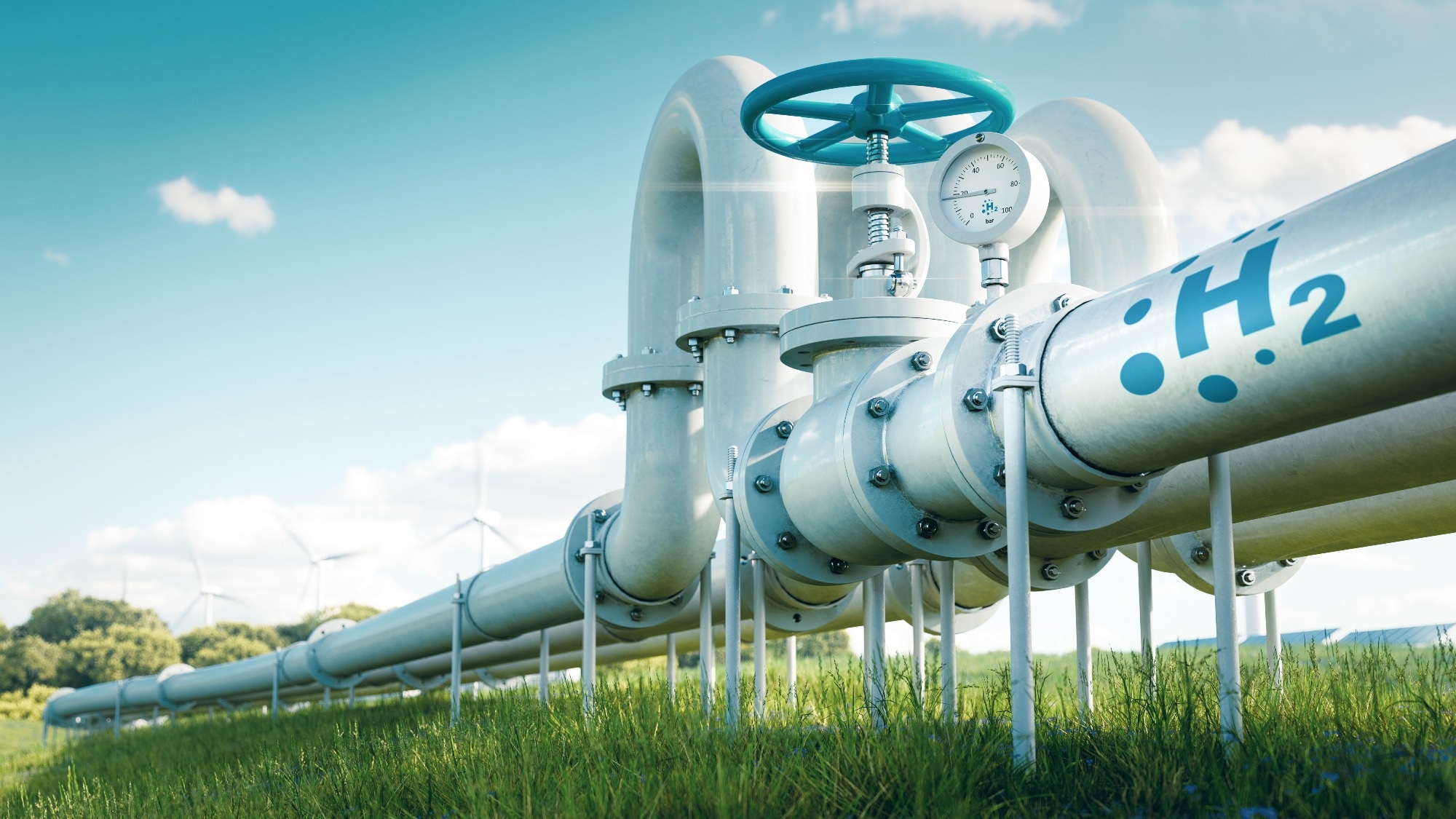In this interview, AZoM talks with Bruno Pollet, Deputy Director at the UQTR Research Hydrogen Institute about the future of clean energy and how hydrogen could lead the way to a more sustainable industry.
What are some of the fundamental aspects of hydrogen, and why is it considered a promising renewable energy source?
Hydrogen boasts a high energy content, surpassing that of traditional fuels. Additionally, it can be utilized in a fuel cell—a system that converts hydrogen and oxygen from the air into electricity and water, with water being the sole byproduct. This means no particulates or CO2 emissions.
Another option is to burn hydrogen in a specially designed engine. While this process does emit certain undesirable chemicals, they can be efficiently neutralized.
Hydrogen is a versatile fuel applicable in various industrial sectors and transportation. However, the challenge lies in the fact that you cannot simply obtain hydrogen from the ground.
Although there are ongoing industry efforts to explore the possibility of naturally occurring hydrogen, known as white hydrogen, this requires extensive research and development.
At present, the sole method for hydrogen production involves breaking down a molecule, whether it is water or an organic substance. This process requires energy to break the large molecule and generate hydrogen.
In certain cases, hydrogen can be produced in an environmentally friendly manner using renewable energy systems and technologies, such as electrolyzers, which break down water into hydrogen and oxygen, resulting in green or renewable hydrogen.
While this is a commendable approach, the drawback is the high energy intensity of the process—about 55 kilowatt-hours of energy are needed to produce one kilogram of hydrogen. Addressing this challenge requires exploring different systems and processes to reduce energy consumption.

Image Credit: petrmalinak/Shutterstock.com
What are some of the current trends and developments that you see shaping the evolution of hydrogen creation for consumption?
We are currently examining two types of hydrogen. The first is known as low-carbon hydrogen, where natural gas and fossil fuels are utilized, and efforts are made to capture the resulting CO2 through a process called carbon capture and sequestration. Essentially, CO2 is either stored underground or simultaneously produced while generating hydrogen.
The second type is renewable hydrogen, which involves producing green electrons to power electrolyzers—large systems used to generate hydrogen. This is the current focus: low-carbon hydrogen and renewable hydrogen. It is crucial to remember, however, that the primary goal of these efforts is to decarbonize our society.
What are the complexities associated with the decarbonization process, and how does the concept of a low-carbon version contribute to industrial innovation?
Our focus is on minimizing CO2 emissions in the production process. We are exploring various systems and materials to effectively capture CO2 and other greenhouse gases. In our research, we aim to significantly reduce CO2 emissions. In the United States, the current standard is three kilograms of CO2 emitted per kilogram of hydrogen, which is considered a clean hydrogen production.
However, our goal is to further reduce both CO2 emissions and other greenhouse gases. This is our primary objective. Decarbonization, in essence, means striving to eliminate CO2 emissions, though we acknowledge we are far from achieving that. The 2050 target is ambitious, but collaboration is crucial to finding solutions rapidly.
When it comes to hydrogen use for renewable energy production, what breakthroughs, innovations, and, more importantly, use cases do you find valuable?
First and foremost, we should consider the circular economy. We currently have ongoing projects centered on converting wastewater into hydrogen and other value-added products. For instance, in the agricultural sector, projects in both the UK and the US are exploring the recovery of wastewater from large farms to produce struvite, a type of fertilizer, along with hydrogen simultaneously. Thus, the wastewater treatment plant is not just cleaning water but also generating hydrogen for use in the plant or other industry sectors.
Another aspect to consider is the need for energy efficiency. To make the most of the energy used in the process, there is a concept gaining attention called pyrolysis. This involves producing hydrogen from natural gas through a process that also yields carbon black, which finds applications in various industries, such as in tires.
We are also looking into addressing the plastic issue. Given the abundance of plastic, the focus is on extracting hydrogen and other value-added products from it. Research plays a crucial role in this sector, and collaboration is key. Whether in the US, Canada, or Europe, we need to innovate collectively and find quick solutions to meet the 2050 decarbonization target.

Image Credit: arturnichiporenko/Shutterstock.com
What can policymakers, governments, and individuals within the industry do to impact the growth and development of hydrogen?
There are a few key aspects. Firstly, they must actively promote research and development (R&D) in academia and industry, ensuring close collaboration between the two to find practical solutions.
While blue sky research is essential, emphasis should also be placed on applied research to swiftly integrate findings into the industry.
Secondly, addressing regulations is crucial. Currently, global regulations about hydrogen lack uniformity. The definition and significance of renewable hydrogen vary across different regions worldwide. Achieving uniformity in language and regulatory frameworks is vital for effective policies to facilitate hydrogen penetration in various sectors.
Observing the current landscape, numerous hydrogen companies are entering the market intending to saturate processes, but the challenge lies in the scarcity of buyers or off-takers.
According to recent reports from the International Energy Agency (IEA) on hydrogen, only about 4% of projects globally progressed to the final investment decision stage. This figure underscores the need for more comprehensive funding of projects from inception to completion.
A strategic focus should be placed on targeting the hard-to-abate sectors—industries with significant pollution, energy intensity, and long-haul transport—where electrification is not a viable solution. Examples include metallurgy, steel production, and fertilizer manufacturing, specifically ammonia production.
These industries are not only energy-intensive but also major contributors to CO2 emissions, making them critical areas for hydrogen adoption.
Could you discuss the distinct characteristics of hydrogen regarding its storage, transportation, and utilization as an alternative fuel?
When dealing with fuels and gases, utmost care is essential, especially when handling hydrogen. Hydrogen is unique in that it is a remarkably small molecule with the ability to permeate various types of metals. Handling it requires meticulous attention due to its propensity to escape. This is commonly referred to as hydrogen embrittlement, prompting ongoing research to explore different materials that prevent hydrogen leaks.
The containment of hydrogen poses a considerable challenge, necessitating specialized materials and containers. For instance, hydrogen fuel cell cars utilize robust containers with a steel core and thick carbon fibers to ensure there are no leaks. However, like any other gas, the handling of hydrogen demands careful attention and extensive training.
Contrary to the notion that producing and using hydrogen is a straightforward process, adherence to regulations and rigorous training are imperative.
What are some aspects of hydrogen development and usage that you think are worth investing in?
I think exploring how to produce hydrogen without using electrons is a significant avenue. For instance, utilizing light or photons through a process known as photocatalysis would be groundbreaking. Essentially, harnessing light to produce hydrogen is a promising approach.
Another aspect to explore is converting various types of waste into hydrogen. This involves different processes, ranging from high-temperature processes to low-temperature ones. This is crucial in the context of a circular economy and advancing the next generation of hydrogen-producing technologies. This is where substantial reductions can be achieved.
It is also essential to find ways to enhance system efficiency, especially considering the integration of renewable energy systems. When powering up your electrolyzer with renewable energy, it's vital to address efficiency concerns. This is a key factor in making the entire system more efficient.
About the Speaker

Bruno G. Pollet is a Professor of Chemistry at the Université du Québec à Trois-Rivières (UQTR), Deputy Director of the UQTR Research Hydrogen Institute (HRI) scientific development and partnerships, Adjunct Professor of Renewable Energy at the Norwegian University of Science and Technology (NTNU), member of the “NTNU Team Hydrogen” (the largest hydrogen R&D cluster in Norway), Extraordinary Professor in Hydrogen Energy at the University of the Western Cape (South Africa) and has been appointed as President of the Green Hydrogen Division of the International Association for Hydrogen Energy. His research covers a wide range of areas from the development of novel materials for low-temperature fuel cells and water electrolyzers, hydrogen production from (non-)pure waters, organics and bio-wastes, to fuel cell and electrolyzer systems, demonstrators and prototypes. He co-founded and co-directed the Birmingham Centre for Hydrogen and Fuel Cell Research (UK) and was Director of HySA Systems Integration & Technology Validation Competence Centre (South Africa). He has worked for Johnson Matthey Fuel Cells Ltd (UK) and other various industries worldwide. He gained his PhD in Physical Chemistry in the field of Electrochemistry and Sonochemistry at Coventry University (UK) and undertook his PostDoc in Electrocatalysis at the Liverpool University Electrochemistry (UK). He serves on several associations and industry boards as well as editorial boards of international journals (Elsevier, Royal Society of Chemistry, Springer & Wiley).

This information has been sourced, reviewed and adapted from materials provided by Technetics Group.
For more information on this source, please visit Technetics Group.
Disclaimer: The views expressed here are those of the interviewee and do not necessarily represent the views of AZoM.com Limited (T/A) AZoNetwork, the owner and operator of this website. This disclaimer forms part of the Terms and Conditions of use of this website.